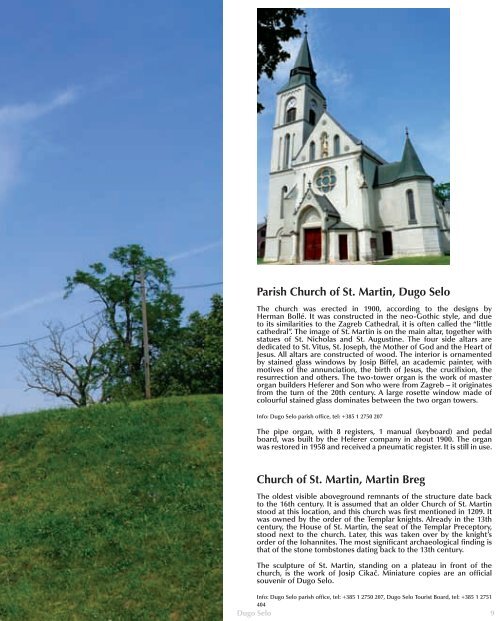The Cultural Heritage of Zagreb County
The Cultural Heritage of Zagreb County
The Cultural Heritage of Zagreb County
You also want an ePaper? Increase the reach of your titles
YUMPU automatically turns print PDFs into web optimized ePapers that Google loves.
Parish Church <strong>of</strong> St. Martin, Dugo Selo<br />
<strong>The</strong> church was erected in 1900, according to the designs by<br />
Herman Bollé. It was constructed in the neo-Gothic style, and due<br />
to its similarities to the <strong>Zagreb</strong> Cathedral, it is <strong>of</strong>ten called the “little<br />
cathedral”. <strong>The</strong> image <strong>of</strong> St. Martin is on the main altar, together with<br />
statues <strong>of</strong> St. Nicholas and St. Augustine. <strong>The</strong> four side altars are<br />
dedicated to St. Vitus, St. Joseph, the Mother <strong>of</strong> God and the Heart <strong>of</strong><br />
Jesus. All altars are constructed <strong>of</strong> wood. <strong>The</strong> interior is ornamented<br />
by stained glass windows by Josip Biffel, an academic painter, with<br />
motives <strong>of</strong> the annunciation, the birth <strong>of</strong> Jesus, the crucifixion, the<br />
resurrection and others. <strong>The</strong> two-tower organ is the work <strong>of</strong> master<br />
organ builders Heferer and Son who were from <strong>Zagreb</strong> – it originates<br />
from the turn <strong>of</strong> the 20th century. A large rosette window made <strong>of</strong><br />
colourful stained glass dominates between the two organ towers.<br />
Info: Dugo Selo parish <strong>of</strong>fice, tel: +385 1 2750 207<br />
<strong>The</strong> pipe organ, with 8 registers, 1 manual (keyboard) and pedal<br />
board, was built by the Heferer company in about 1900. <strong>The</strong> organ<br />
was restored in 1958 and received a pneumatic register. It is still in use.<br />
Church <strong>of</strong> St. Martin, Martin Breg<br />
<strong>The</strong> oldest visible aboveground remnants <strong>of</strong> the structure date back<br />
to the 16th century. It is assumed that an older Church <strong>of</strong> St. Martin<br />
stood at this location, and this church was first mentioned in 1209. It<br />
was owned by the order <strong>of</strong> the Templar knights. Already in the 13th<br />
century, the House <strong>of</strong> St. Martin, the seat <strong>of</strong> the Templar Preceptory,<br />
stood next to the church. Later, this was taken over by the knight’s<br />
order <strong>of</strong> the Iohannites. <strong>The</strong> most significant archaeological finding is<br />
that <strong>of</strong> the stone tombstones dating back to the 13th century.<br />
<strong>The</strong> sculpture <strong>of</strong> St. Martin, standing on a plateau in front <strong>of</strong> the<br />
church, is the work <strong>of</strong> Josip Cikač. Miniature copies are an <strong>of</strong>ficial<br />
souvenir <strong>of</strong> Dugo Selo.<br />
Info: Dugo Selo parish <strong>of</strong>fice, tel: +385 1 2750 207, Dugo Selo Tourist Board, tel: +385 1 2751<br />
404<br />
Dugo Selo 9



